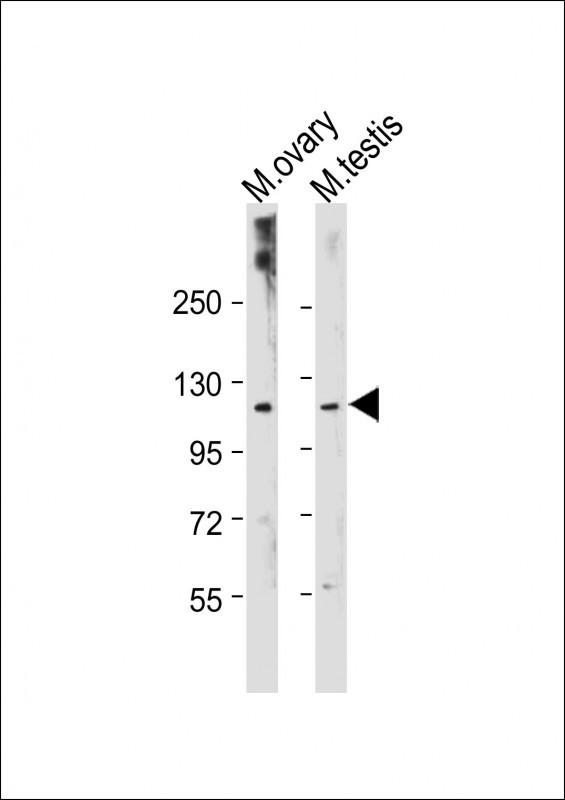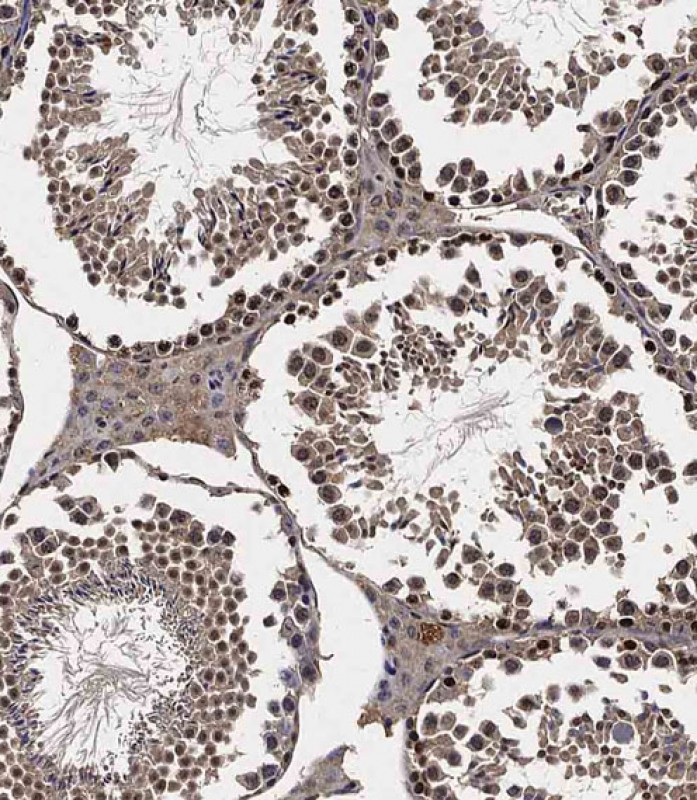Mouse Lats2 Antibody(C-term)
Affinity Purified Rabbit Polyclonal Antibody (Pab)
- SPECIFICATION
- CITATIONS
- PROTOCOLS
- BACKGROUND

Application
| IHC-P, WB, E |
|---|---|
| Primary Accession | Q7TSJ6 |
| Other Accession | NP_056586.2 |
| Reactivity | Mouse |
| Host | Rabbit |
| Clonality | Polyclonal |
| Isotype | Rabbit IgG |
| Calculated MW | 115472 Da |
| Antigen Region | 1000-1027 aa |
| Gene ID | 50523 |
|---|---|
| Other Names | Serine/threonine-protein kinase LATS2, Kinase phosphorylated during mitosis protein, Large tumor suppressor homolog 2, Serine/threonine-protein kinase kpm, Lats2 {ECO:0000312|EMBL:AAH530281} |
| Target/Specificity | This Mouse Lats2 antibody is generated from rabbits immunized with a KLH conjugated synthetic peptide between 1000-1027 amino acids from the C-terminal region of mouse Lats2. |
| Dilution | IHC-P~~1:100 WB~~1:2000 E~~Use at an assay dependent concentration. |
| Format | Purified polyclonal antibody supplied in PBS with 0.09% (W/V) sodium azide. This antibody is purified through a protein A column, followed by peptide affinity purification. |
| Storage | Maintain refrigerated at 2-8°C for up to 2 weeks. For long term storage store at -20°C in small aliquots to prevent freeze-thaw cycles. |
| Precautions | Mouse Lats2 Antibody(C-term) is for research use only and not for use in diagnostic or therapeutic procedures. |
| Name | Lats2 {ECO:0000312|EMBL:AAH53028.1} |
|---|---|
| Function | Negative regulator of YAP1 in the Hippo signaling pathway that plays a pivotal role in organ size control and tumor suppression by restricting proliferation and promoting apoptosis (By similarity). The core of this pathway is composed of a kinase cascade wherein STK3/MST2 and STK4/MST1, in complex with its regulatory protein SAV1, phosphorylates and activates LATS1/2 in complex with its regulatory protein MOB1, which in turn phosphorylates and inactivates YAP1 oncoprotein and WWTR1/TAZ (By similarity). Phosphorylation of YAP1 by LATS2 inhibits its translocation into the nucleus to regulate cellular genes important for cell proliferation, cell death, and cell migration (By similarity). Also phosphorylates YAP1 in response to cell contact inhibition-driven WWP1 ubiquitination of AMOTL2, which results in LATS2 activation (By similarity). Acts as a tumor suppressor which plays a critical role in centrosome duplication, maintenance of mitotic fidelity and genomic stability (PubMed:15343267). Negatively regulates G1/S transition by down-regulating cyclin E/CDK2 kinase activity (By similarity). Negative regulator of the androgen receptor (By similarity). Phosphorylates SNAI1 in the nucleus leading to its nuclear retention and stabilization, which enhances its epithelial-mesenchymal transition and tumor cell invasion/migration activities (By similarity). This tumor-promoting activity is independent of its effects upon YAP1 or WWTR1/TAZ (By similarity). Acts as an activator of the NLRP3 inflammasome by mediating phosphorylation of 'Ser-265' of NLRP3 following NLRP3 palmitoylation, promoting NLRP3 activation by NEK7 (PubMed:39173637). |
| Cellular Location | Cytoplasm, cytoskeleton, microtubule organizing center, centrosome. Cytoplasm. Cytoplasm, cytoskeleton, spindle pole. Nucleus. Note=Colocalizes with AURKA at the centrosomes during interphase, early prophase and cytokinesis (By similarity). Migrates to the spindle poles during mitosis, and to the midbody during cytokinesis. Translocates to the nucleus upon mitotic stress by nocodazole treatment (By similarity) |
| Tissue Location | Expressed at high levels in ovary and testis and at lower levels in all other tissues examined |

Thousands of laboratories across the world have published research that depended on the performance of antibodies from Abcepta to advance their research. Check out links to articles that cite our products in major peer-reviewed journals, organized by research category.
info@abcepta.com, and receive a free "I Love Antibodies" mug.
Provided below are standard protocols that you may find useful for product applications.
Background
Negative regulator of YAP1 in the Hippo signaling pathway that plays a pivotal role in organ size control and tumor suppression by restricting proliferation and promoting apoptosis. The core of this pathway is composed of a kinase cascade wherein MST1/MST2, in complex with its regulatory protein SAV1, phosphorylates and activates LATS1/2 in complex with its regulatory protein MOB1, which in turn phosphorylates and inactivates YAP1 oncoprotein and WWTR1/TAZ. Phosphorylation of YAP1 by LATS2 inhibits its translocation into the nucleus to regulate cellular genes important for cell proliferation, cell death, and cell migration. Acts as a tumor suppressor which plays a critical role in centrosome duplication, maintenance of mitotic fidelity and genomic stability. Negatively regulates G1/S transition by down-regulating cyclin E/CDK2 kinase activity. Negative regulator of the androgen receptor (By similarity).
References
Zhang, N., et al. Dev. Cell 19(1):27-38(2010)
Oh, S., et al. Mol. Cell. Biol. 29(23):6309-6320(2009)
Quina, L.A., et al. J. Neurosci. 29(45):14309-14322(2009)
Nishioka, N., et al. Dev. Cell 16(3):398-410(2009)
Matsui, Y., et al. Circ. Res. 103(11):1309-1318(2008)
If you have used an Abcepta product and would like to share how it has performed, please click on the "Submit Review" button and provide the requested information. Our staff will examine and post your review and contact you if needed.
If you have any additional inquiries please email technical services at tech@abcepta.com.













 Foundational characteristics of cancer include proliferation, angiogenesis, migration, evasion of apoptosis, and cellular immortality. Find key markers for these cellular processes and antibodies to detect them.
Foundational characteristics of cancer include proliferation, angiogenesis, migration, evasion of apoptosis, and cellular immortality. Find key markers for these cellular processes and antibodies to detect them. The SUMOplot™ Analysis Program predicts and scores sumoylation sites in your protein. SUMOylation is a post-translational modification involved in various cellular processes, such as nuclear-cytosolic transport, transcriptional regulation, apoptosis, protein stability, response to stress, and progression through the cell cycle.
The SUMOplot™ Analysis Program predicts and scores sumoylation sites in your protein. SUMOylation is a post-translational modification involved in various cellular processes, such as nuclear-cytosolic transport, transcriptional regulation, apoptosis, protein stability, response to stress, and progression through the cell cycle. The Autophagy Receptor Motif Plotter predicts and scores autophagy receptor binding sites in your protein. Identifying proteins connected to this pathway is critical to understanding the role of autophagy in physiological as well as pathological processes such as development, differentiation, neurodegenerative diseases, stress, infection, and cancer.
The Autophagy Receptor Motif Plotter predicts and scores autophagy receptor binding sites in your protein. Identifying proteins connected to this pathway is critical to understanding the role of autophagy in physiological as well as pathological processes such as development, differentiation, neurodegenerative diseases, stress, infection, and cancer.



